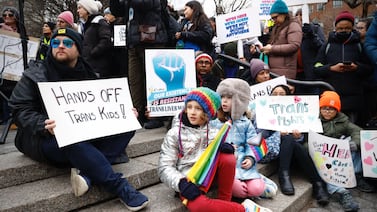The number of Indiana high school students who are heading to college has fallen to 53%, a significant drop after years of declining enrollment, according to data released by state officials in a Thursday morning meeting.
The Indiana Commission for Higher Education data is for the state’s 2020 high school class, the first to graduate during the COVID-19 pandemic.
The data shows the college-going rate has dropped 6 percentage points over the last year — 12 percentage points lower than five years ago — with widening gaps for students of color and students from low-income families.
The COVID-19 pandemic has caused drops in college enrollment, but the commission stressed that enrollment saw a decline even before then. The commission cited the perceived cost of higher education and low unemployment rates as possible factors in the continued decline.
“I want to make clear, though, that we cannot just blame this on the pandemic,” Sean Tierney, ICHE associate commissioner for policy and research, said at the meeting.
Dhanfu Elston, chief of staff and senior vice president for strategy at Complete College America, said a competitive job market often can force students to reconsider higher education plans.
“Whenever a student can potentially get a job paying well beyond minimum wage, in some cases, double and triple that amount, it’s going to make them rethink everything,” Elston said.
In order for higher education institutions to see students return, they will have to emphasize the long-term benefits, Elston added.
“There’s also this recognition that institutions don’t always do well, especially for minoritized populations — under-resourced students, first-generation students, rural students, community colleges — in letting them know: This is what you can do. These are the careers. Here’s the demand in our particular field.”
While college enrollment has decreased across the nation, Indiana’s college-going rates have fallen further than most states. Currently, the college-going rate nationwide is 63%, with Indiana trailing 10 percentage points behind.
The college-going rate among Black students in Indiana fell by 7 percentage points, meaning the group now has the lowest college-going rate by ethnicity at 43%. Hispanic and Latino students’ college-going rate also dipped considerably, with a 6 percentage point decrease to 44%. The trends also fell more steeply among low-income students, where only about 1 in 3 high schoolers pursues higher education. However, 81% of the 2020 class of 21st Century Scholars, a program that pays some or all of the tuition for lower-income students, are going to college.
The education attainment rates in Indiana – working-age adults who have completed some form of higher education – are also low when compared to national averages. The state has set a goal for 60% of the adult population to complete some form of higher education by the year 2025, but currently Indiana stands at just 48%.
The report revealed that in 2020, 61% of women went to college while only 46% of men did. This is the first time in recent years where less than 50% of men sought some form of higher education. In keeping with national trends, the gender gap in higher education in Indiana has widened over the last 10 years.
“Men, in many cases, are working to try to figure out how do they support their families,” Elston said. “In many cases, the opportunities and the disparities in wages between men and women allow for more men to see opportunities than for women.”
Indiana Commissioner for Higher Education Chris Lowery said the data was startling and pushed the board to consider the next steps to increase higher education enrollment.
“Indiana’s sharp one-year college-going decline is alarming, and we have to treat it as such,” Lowery said in a statement Thursday morning. “We know individual lives and the state’s economy depend on and thrive with an educated society,”
A study presented by the commission found that while the majority of Hoosiers still feel favorably toward higher education, there are negative views motivated by its perceived cost. Currently, higher education is most frequently associated with four-year bachelor’s degrees, leaving out associate degrees and trade school certificates.
Correction: June 10, 2022: A previous version of this story gave an outdated figure for Indiana’s higher education attainment rate.
Chalkbeat Indiana partners with Open Campus on higher education coverage.
Helen Rummel is a summer reporting intern covering education in the Indianapolis area. Contact Helen at hrummel@chalkbeat.org.







